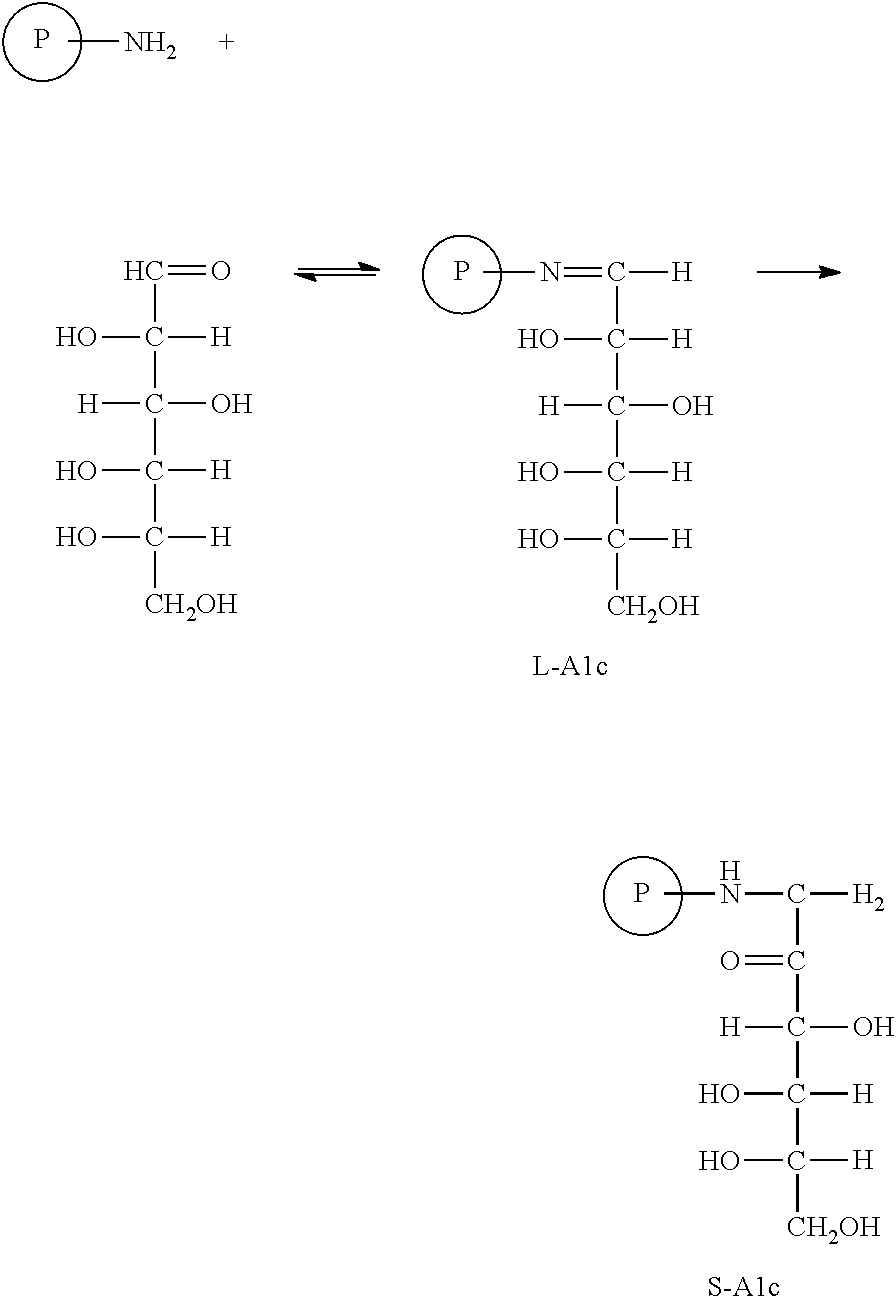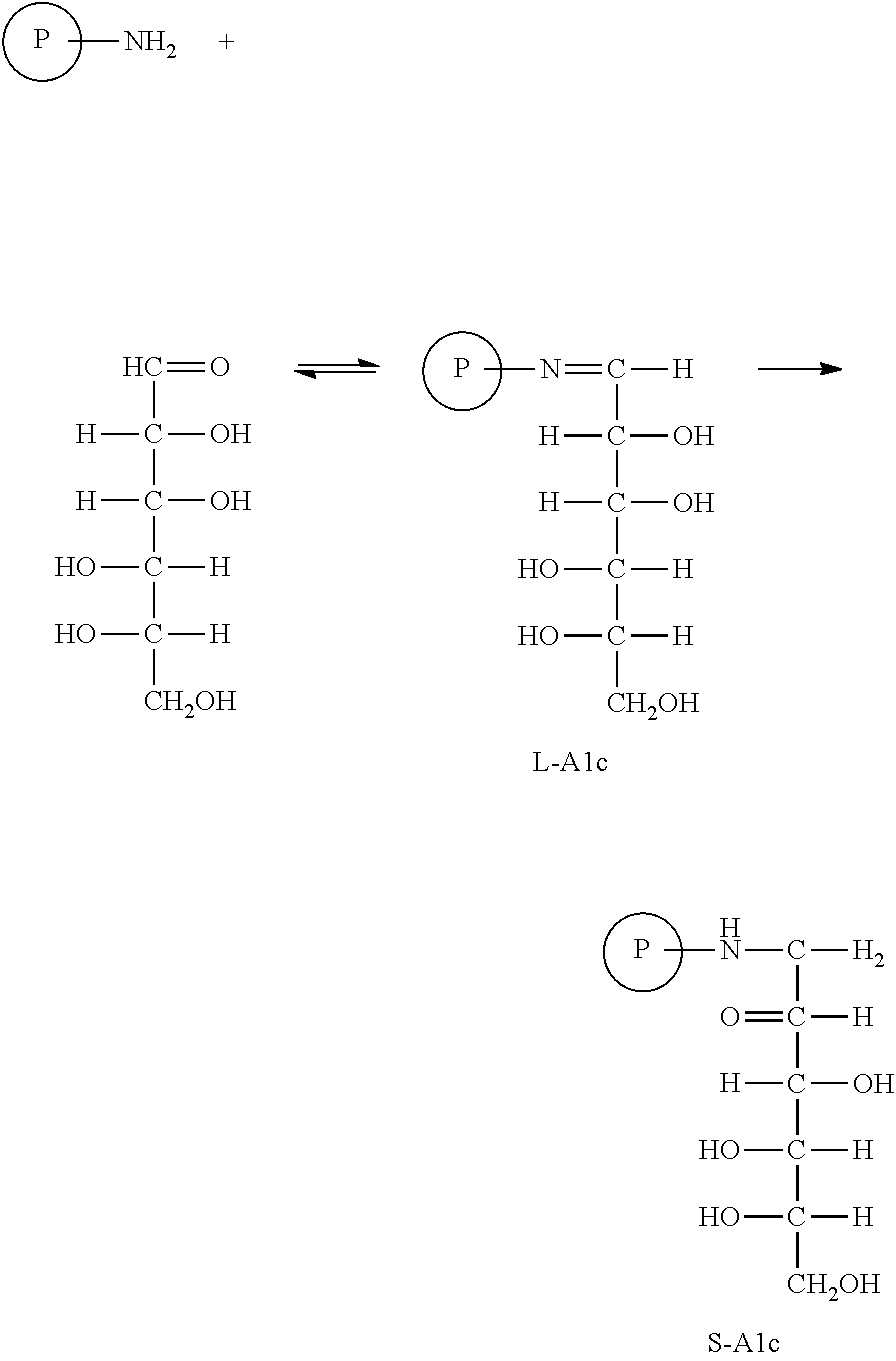Cis di-ahl modified controls for glycated hemoglobin S-A1c derived from healthy blood cells
a technology of glycated hemoglobin and modified controls, which is applied in the field of healthy blood cell compositions, can solve the problems that controls cannot be utilized to create universal controls, controls cannot be modified to produce universal controls, and many alc controls fail to produce controls that resemble real patient blood samples, etc., to achieve good accuracy and precision, avoid hemoglobin loss, and maintain storage stability
- Summary
- Abstract
- Description
- Claims
- Application Information
AI Technical Summary
Benefits of technology
Problems solved by technology
Method used
Image
Examples
examples 1 to 16
[0076]Red blood cells are processed as described above adjusting the glucose and catalyst concentration. The final stabilized product contained 3% percent sorbitol. The S-Alc concentrations are measured by HPLC, Immunoassay and Boronate Affinity. The results are compiled in Table 5.
[0077]
TABLE 5Condition (temp. = 37° C.)Final S-A1c cocn. (%)catalystImmu-ExampleGlucosecatalystconc.HPLCnoassayAffinity16%adenosine0.50%10.58.6—2inosine0.50%10.910.58.636%inosine0.50%11.710.112.64adenosine0.50%11.810.6—56%no catalyst0.00%9.28.69.96adenosine0.40%9.48.910.47inosine0.20%9.89.38.580.40%10.38.69.190.50%9.79.49.4106%inosine0.40%9.89.313.3116%inosine0.40%10.49.510.4125%inosine0.30%9.88.6813inosine0.40%9.88.48146%inosine0.30%9.99.29.715inosine0.40%108.910.2166%inosine0.40%10.49.39.7
[0078]Table 5 illustrates the impact of sorbitol on the consistency of the standard analytical methods.
examples 17 to 34
[0079]Several samples are prepared using levels of 3 and 6 percent of sorbitol in the stabilized final aqueous suspension. In the preparation of the samples the level and purine catalyst are varied. The glucose concentration in the glycation step is 6 percent and the purine catalyst level in 0.5 percent by weight, except where noted in the glycation suspension. The final aqueous suspensions are tested for S-Alc glycated hemoglobin concentration by boron affinity, high pressure liquid chromatography and immunoassay techniques. The results are compiled in Table 6. Level 1 as used in Table 6 means the diluent as described in Table 4.
[0080]
TABLE 6S-A1cCatalyst / S-A1cImmuno-S-A1cExampleConcentrationDiluentAffinityassayHPLC17noneLevel 126.89.61018noneLevel 1 +10.89.29.5Sorbitol 6%19adenosine (0.5)Level 120.58.71120adenosine (0.5)Level 1 +8.610.5Sorbitol 6%21guanosine (0.5)Level 116.59.010.922guanosine (0.5)Level 1 +119.610.7Sorbitol 6%23inosine (0.5)Level 117.810.811.124inosine (0.5)Level ...
examples 35 to 37
[0081]Several samples are prepared as described hereinbefore using 2 percent of sorbitol in the stabilized final aqueous suspension. The mannose concentration in the glycation step is 6 percent. The final aqueous suspensions are tested for S-Alc glycated hemoglobin concentration by boron affinity, high pressure liquid chromatography and immunoassay techniques. The results are compiled in Table 7.
[0082]
TABLE 7S-A1c conc. of the final productTosoh 2.2Tosoh G8GDX CholestechDCA VantageExample(HPLC)(HPLC)(Affinity)(Immunoassay)3511.711.110.210.936No data11.211.210.53712.111.711.210.7
[0083]Table 7 illustrates the effect of sorbitol on the S-Alc values determined by affinity method and shows that the results of all three methods are consistent.
[0084]General Control Preparation Process
PUM
| Property | Measurement | Unit |
|---|---|---|
| weight percent | aaaaa | aaaaa |
| temperature | aaaaa | aaaaa |
| concentration | aaaaa | aaaaa |
Abstract
Description
Claims
Application Information
 Login to View More
Login to View More - R&D
- Intellectual Property
- Life Sciences
- Materials
- Tech Scout
- Unparalleled Data Quality
- Higher Quality Content
- 60% Fewer Hallucinations
Browse by: Latest US Patents, China's latest patents, Technical Efficacy Thesaurus, Application Domain, Technology Topic, Popular Technical Reports.
© 2025 PatSnap. All rights reserved.Legal|Privacy policy|Modern Slavery Act Transparency Statement|Sitemap|About US| Contact US: help@patsnap.com



